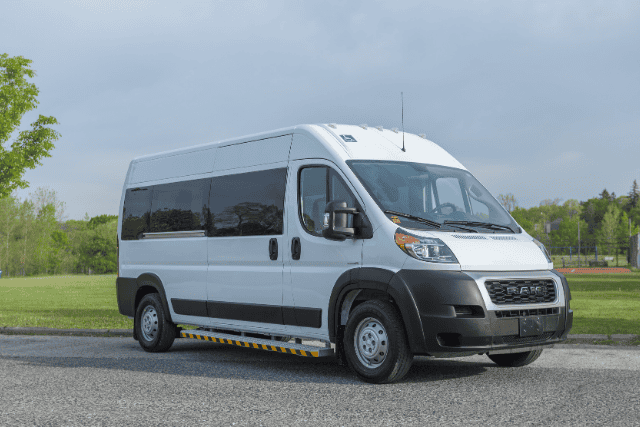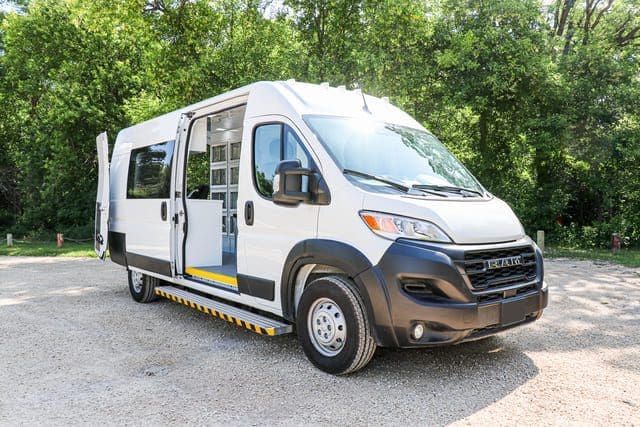Is your organization currently looking to purchase a mobile medical bus? There are a few considerations to keep in mind with these vehicles. Their size poses a challenge when you’re trying to navigate through tight spaces in densely populated cities. It’s also a bit tougher to park a large mobile medical bus in regular parking spots.
At AVAN Mobility, our team has been manufacturing mobile medical vans for over a decade. We like to see our customers making the right choices for their mobile medical program. That’s exactly why we’re writing this article. You don’t want to purchase an expensive medical vehicle that you’ll later regret because it’s not fulfilling your program’s needs, and we’re here to help with that.
In this article, you’re going to learn about the 10 reasons why a mobile medical bus might be too big for your needs. We’ll also finish off by highlighting a suitable alternative for your mobile medical program.
What’s a mobile medical bus?
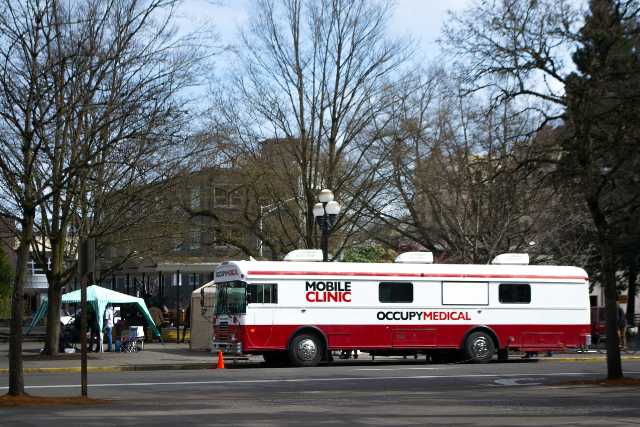
A mobile medical bus is a large vehicle designed to make medical services more accessible.
The sheer size of these buses enables them to have multiple rooms for patients to meet with doctors, and basic waiting areas and break rooms for the medical staff.
The size of buses also allows them to carry a lot of medical equipment. Because of their size, it allows them to offer a variety of medical services, from regular check-ups to more advanced treatments and imaging procedures.
Mobile medical buses can get quite big. They can be as long as 44 feet and weigh up to 30,000 pounds. While the size of these vehicles might be helpful for organizations that are ready to start massive mobile medical programs, it can be a hindrance for others.
10 challenges a mobile medical bus may face
Operating a mobile medical bus is a big job, and the size of the bus matters more than you might think. Let’s take a look at why a large bus might not be the best fit for your needs.
1. Urban congestion
Imagine bringing healthcare to downtown LA in a mobile medical bus. A large bus struggles with tight turns which causes delays and frustration for the driver and patients requiring healthcare.
The notorious traffic congestion of LA adds to the already big problem and starts testing the patience of everyone involved. Lastly, finding a suitable parking spot to fit the large bus in becomes an even bigger puzzle, showing the impracticality of size in a busy city.
2. Remote community access
Providing healthcare to remote villages with twisty roads and uneven terrain in the U.S. is tough for a big bus. Picture a healthcare mission to a secluded village with challenging landscapes. The winding roads become like an obstacle course for the large bus, making the journey dangerous. Driving around the sharp turns becomes too much of a challenge, leaving the health needs of the community unmet.
4. Challenges with maintenance
Maintaining a large bus is tough. Picture an organization that’s committed to providing regular check-ups for their patients. They’re facing multiple issues with their bus, and routine inspections are becoming a hassle.
This starts to cause delays in the healthcare the team provides, but they know that not resolving the issues impacts the reliability of healthcare services.
5. Fuel efficiency frustrations
Traveling to isolated communities with a large mobile medical bus uses a lot of gas. With frequent missions, the cost of refueling adds up fast. This creates a financial burden, and you need to carefully consider whether the benefits of having a big bus outweigh the ongoing high fuel costs.
Striking a balance between the advantages of size and the need for fuel efficiency is important to make sure your healthcare outreach remains cost-effective and sustainable in the long run.
6. Community engagement
Picture the mobile medical bus pulling into a small community. The problem? The bus is so big it might scare people away instead of making them feel welcome. In smaller places, it’s tough for folks to approach a massive vehicle for healthcare assistance.
Choosing a smaller and friendlier option could help your organization connect better with the community. It builds trust and makes sure your vehicle feels like a friendly helper instead of just a big, daunting vehicle.
7. Integration with public events
Imagine trying to participate in community events or fairs with a large mobile medical bus. A smaller and more versatile vehicle seamlessly merges into these public spaces. A large bus may struggle to find suitable spots or even disrupt the event layout with its size.
Opting for a size that blends effortlessly into public events improves your ability to connect with diverse communities. It’ll help your organization create positive interactions and strengthen your presence in local gatherings.
8. Maneuverability in emergency situations
Think about responding to emergency situations where time is of the essence. A smaller and more maneuverable vehicle can navigate through traffic and tight spaces quickly. On the other hand, a large bus may struggle to reach locations promptly.
Is your organization going to be providing any form of healthcare services that require getting patients to hospitals for emergency services? If so, opting for a size that ensures nimble maneuverability allows your organization to respond effectively to urgent healthcare needs.
9. Patients might just feel like a number
Consider a scenario where a patient goes into a massive mobile medical bus for the first time. The large size of the bus might make it feel a bit impersonal, intimidating, and like they’re in a brick-and-mortar clinic. Larger vehicles, like buses, can create a sense of patients being just another number in a crowd of others receiving healthcare services.
On the other hand, smaller mobile medical vehicles offer a cozier space where patients experience more personalized care. Choosing a size that feels less like a big bus has patients feeling more connected and valued.
10. Cost considerations of mobile medical buses
Lastly, when it comes to costs, bigger mobile medical buses hit your budget harder than their smaller counterparts, like vans. Their large size means higher expenses in maintenance, fuel consumption, and initial acquisition. Additionally, accommodating their size requires specialized facilities, adding more to the bill.
What’s the alternative to mobile medical buses?
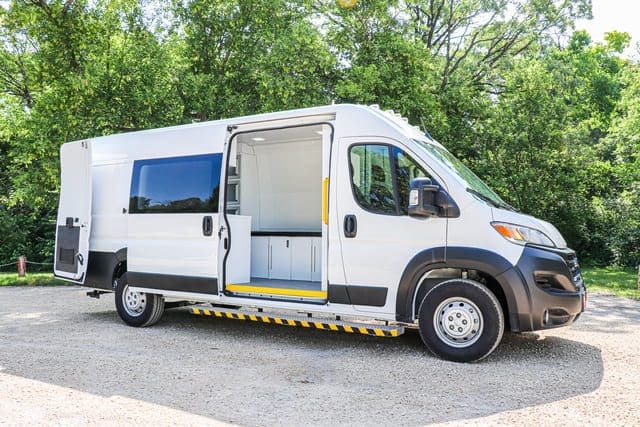
When it comes to bringing healthcare to people around the U.S., the size of the vehicle matters. That’s where mobile medical vans step into the spotlight. Let’s take a deeper look at how mobile medical vans excel.
Versatility and reach
Mobile medical vans have a clear edge when it comes to versatility. Their smaller size allows them to navigate through tight spots and reach areas where larger buses struggle. This means they reach more places, especially those tucked away in remote or challenging terrains where a big bus would find it tough to get to.
Easy parking, better access
Finding a parking spot in a busy city or a crowded event can be frustrating no matter what type of vehicle you have. It’s exceptionally more frustrating if you have a longer and larger one.
Mobile medical vans have a huge advantage here. Their compact size makes parking a breeze. This gives them easier access to communities in urban areas or during public events. Unlike larger buses, smaller vans can weave in and out of various settings. This helps them provide hassle-free healthcare services without the headaches caused by trying to park them.
Personalized care
The smaller size of mobile medical vans creates a more intimate and comfortable environment for patients. Unlike larger buses that might feel overwhelming and intimidating, vans offer a setting where patients can experience more personalized care. The coziness of the space helps create a connection between healthcare providers and patients. It makes the experience more individualized and friendly.
Cost-efficiency
Mobile medical vans come with a friendlier price tag compared to their larger bus counterparts. The initial purchase cost is lower, and ongoing maintenance is more affordable. Fuel expenses are reduced thanks to their smaller engines and size. This cost-efficiency translates into a smarter allocation of resources for your organization.
Keep in mind that even though mobile medical vans are smaller than mobile medical buses, their space is utilized very effectively. Take a look at the testimonial below that highlights exactly that.
What mobile medical van options are available?
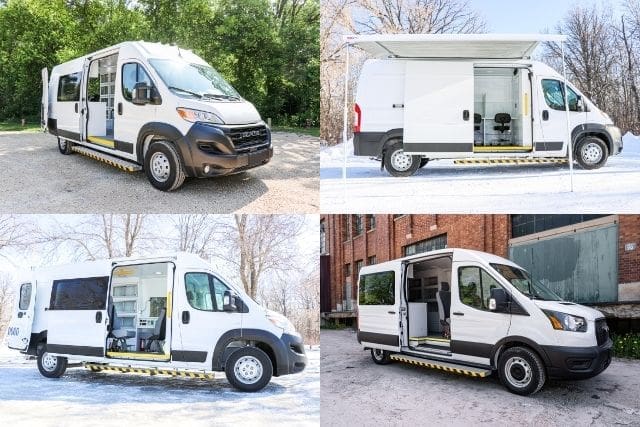
When it comes to mobile medical vans, one size doesn’t fit all. Depending on your organization’s goals and focus, there are four different options to consider:
If you have any questions regarding these vans, click the button at the bottom of this article to reach out to an expert.
Your next steps with AVAN Mobility
You came to this article looking for more information on mobile medical buses. If you’ve made it this far, you now have a better understanding of why the size of mobile medical buses might be a hindrance to the healthcare services you’re aiming to provide.
At AVAN Mobility, we only manufacture mobile medical vans because we find they’re a more versatile and personalized way to overcome healthcare barriers across the U.S. Our vans can be fully customized and tailored to your organization’s needs.
If you’re still trying to decide between mobile medical buses vs. mobile medical vans, you should read our article on that for more information.
You should also read our article on the pros and cons of mobile medical vans and mobile medical RVs to give you a better idea of the differences between these two options.


